
Welcome to the October edition of Zoo News. We have been very busy at Atherton over the past few months. The Sales and Service teams from across Australia and New Zealand came together for the first Training and Development week we have been able to hold in years – a great opportunity to talk about plans for the future and to share experiences and knowledge across the team. Also in this edition of Zoo News we discuss the important issue of clean steam, not only for equipment efficiency but also for patient safety; we meet Lisa Li, Nurse Unit Manager from Box Hill Hospital, and update you on important upcoming events including the final planned Study Day for 2022.
In September Atherton held its annual Training and Development Week for senior sales and service staff, bringing together Atherton team members from all over Australia and New Zealand to for the first time in several years.
The pandemic brought significant challenges as all have struggled to operate in a very different environment while the health services profession and sterilization industry have been under significant pressure and demand. The Training and Development week provided an opportunity for some key Atherton staff to gather together to share learnings and experiences and continue to improve upon our service and support to customers.
The week included training presentations on new products and the latest innovations in sterilization technology and discussions on customer feedback gathered through recent surveys and research. It was also a great opportunity for Atherton staff to reconnect after a few years of COVID-restricted travel.
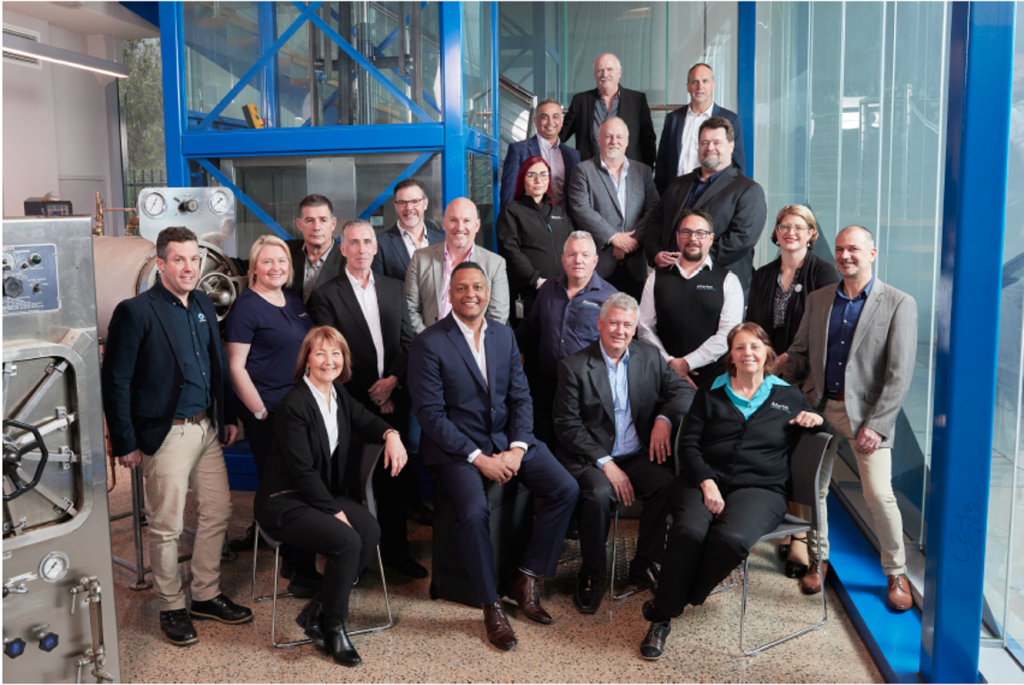
Front Row (Sitting Down, left to right):
Alison Little, Jean Danré, Brett Benz, Jeanette McGibbony.
Second Row (Standing up):
Damian Draper, Carol Glen, Steven Gorrie, Ken Simpson, Andy Penhall, John Allen, Brian Littlewood, Daniel Grant, Felicity Bailey, Hugo Ribarich.
Third Row (staircase):
Elisabeth Calcaterra, Greg Harrison, Rod Hamilton,
Rear Row (staircase):
Ashish Bhatia, Jon Walton, Scott Tattersall.
The Australian Commission of Safety and Quality in Health will require steam purity or water quality to be monitored by the end of the year but patient safety and sterilization equipment corrosion are great reasons to get ahead on this issue.
Recent years have seen a growing awareness of the need to improve the quality of steam used for sterilization, driven in part by AS/NZS 4187, but also by increasing concern about the harmful effects that even minute quantities of contaminants may have upon patients and the effectiveness and longevity of sterilization equipment.
A steam sterilizer will be provided steam from either;
The purity of steam can have a major effect on the efficacy of the sterilization process, the quality of the sterile product and the longevity and serviceability of the sterilizer. Plain tap water contains minerals and other contaminants derived from the environment or the water delivery system. To reduce contaminants to a safe level the water supply to steam generators must be treated.
Contaminants in the steam may be deposited on the items being sterilized as the steam condenses during the sterilization cycle. The amount of steam condensing, and the amount of contamination deposited, is proportional to the mass and the heat capacity of the material from which it is made. This means that a heavy metal item will receive more contamination than a light plastic item of similar size and shape.
The amount of contamination remaining at the end of the cycle will depend on how much of this condensate remains on the surface of the product prior to the dry stage. Where condensate can drain freely, only a small fraction of the deposited contaminants will be held in a thin film of water. Where condensate is trapped in cavities or held in the packaging close to the surface, the amount of contamination retained will be much more.
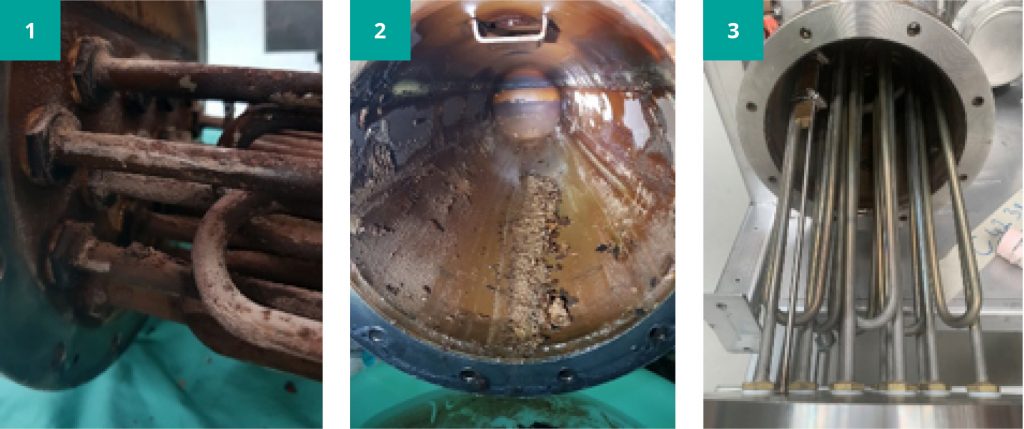
Figures 1 & 2: Steam generator supplied with untreated water after 12 months use. Figure 3: Uncontaminated steam generator
As well as the obvious risks to patients, contaminants in steam may have a damaging effect on the sterilizer itself. These contaminants may cause corrosion and scale build up which will impair the performance of the steam sterilizer.
Contaminants in the steam can also cause failed cycles if non-condensable gasses (NCGs) are formed. NCGs are gases such as carbon dioxide, nitrogen and oxygen dissolved in water that may be present in steam. If air pockets form (bubbles of NCGs) inside the sterilizer chamber they act as a thermal insulator to the steam from the goods to be sterilized. These gases may not always be detected by the equipment monitoring devices or control systems and can compromise the effectiveness of the process
Failure of a component due to poor water quality is not covered by the warranty or comprehensive maintenance contracts offered for steam sterilizers.
Warranty cover on any equipment covers manufacturing defects that may occur during the warranty period. Comprehensive maintenance contracts extend this period but only cover fair wear and tear on components. Neither warranty nor comprehensive maintenance contracts cover damage caused by incorrect services (water, steam, power, compressed air etc) supplied to the equipment.
For these reasons, either the feed water to the steam generator or the steam purity itself must be tested regularly in accordance with AS/NZS 4187. By December 31 of this year, the Australian Commission of Safety and Quality in Health Care expects all organisations to comply with these standards but with the risks outlined here, the benefit of regular testing on patient safety and equipment maintenance is already clear.
According to AS/NZS 4187 clause 7.2.3.2.2, steam purity is to be measured either via:
The method to be used is determined as follows;
a) If the steam to a sterilizer is supplied via a dedicated steam generator, then water quality must meet the requirements of AS/NZS 4187 table 7.4. (This table is identical to table B1 in EN285)
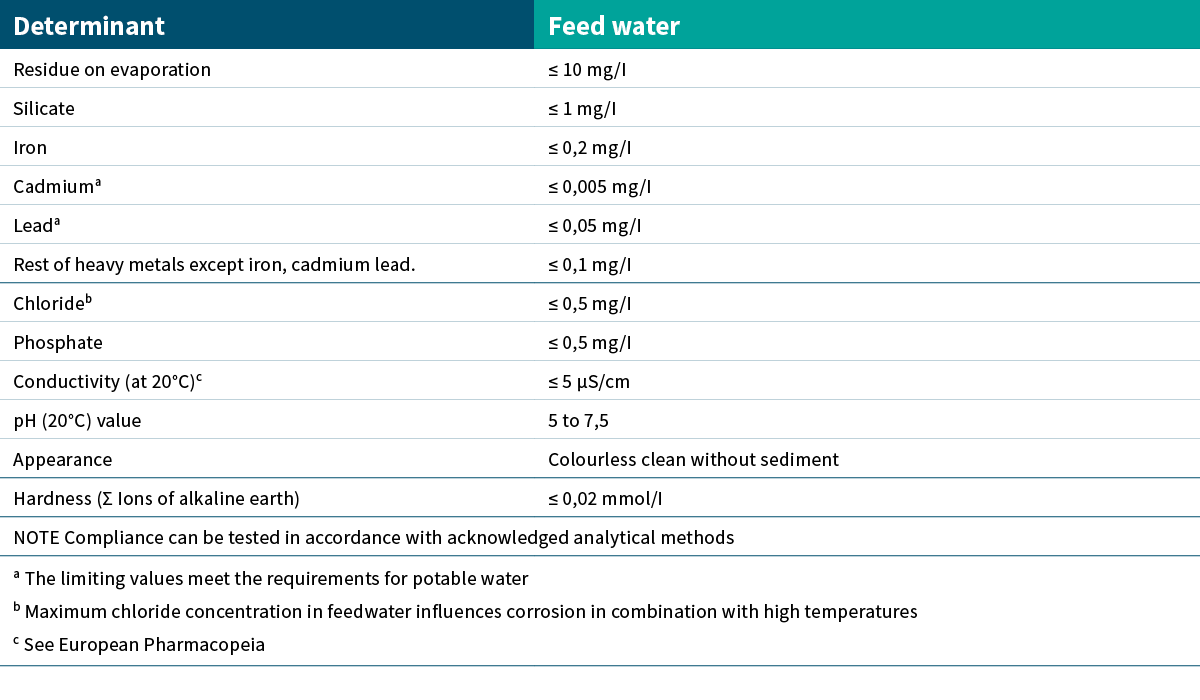
b) For sterilizers that are supplied with a non-dedicated steam generator, then steam condensate purity must meet the requirements of EN285 table 4.
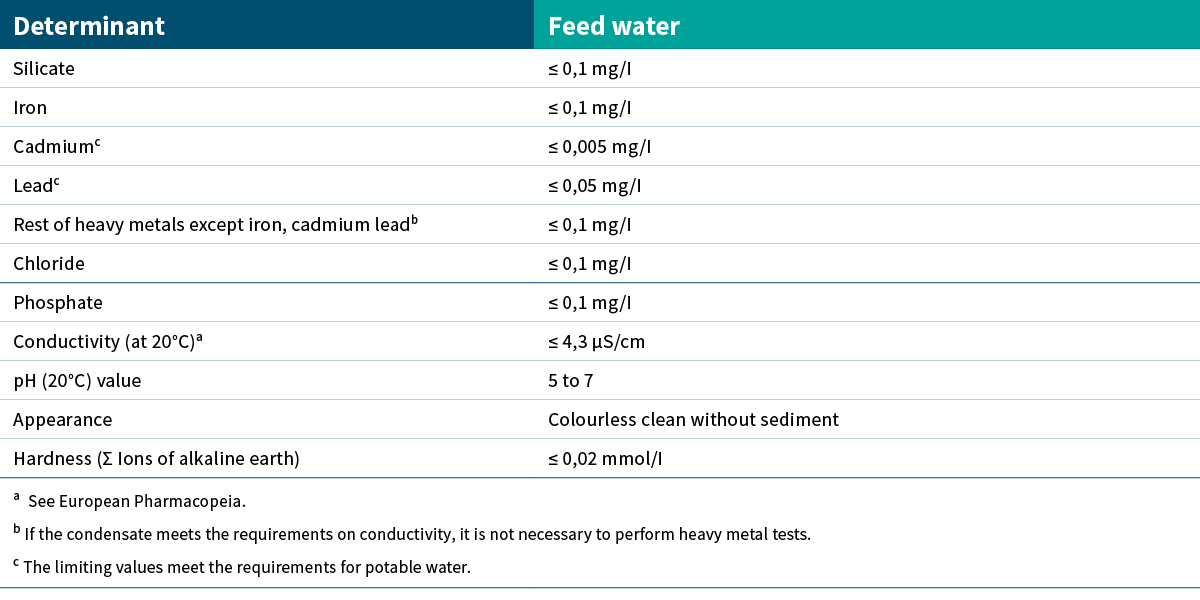
Atherton provides a range of testing and validation services to ensure steam and water quality and purity is in line with relevant standards and safe for patients and equipment. These include steam quality and steam sterilizer purity testing, water quality boiler feed generator testing, and water quality washer-disinfector testing. For more information on these services or to speak with one of our Customer Service team email salesandservice@atherton.net or phone on 1300 580 870
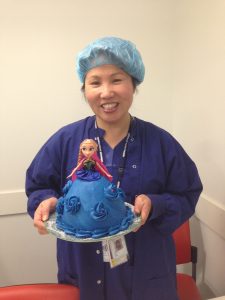
With my solid education and 30-plus years of hands-on professional Perioperative nursing background and CSSD speciality, I’m currently a CSSD manager for Box Hill Hospital in Eastern Health.My colleagues like to describe me as an optimistic, outgoing and self-motivated person who’s always detail oriented and sensitive to quality. It’s my belief that quality is our standard and safety is our priority. I do follow Australian standards such as AS4187 and GENCA to ensure that CSSD operations set patient safety as priority and motivate staff to perform.
Knowing Atherton since 2007, Atherton has a great reputation for manufacturing sterilizers, installation, providing maintenance services and hosting study days for instrument technicians. I had the opportunity to visit the new Atherton site and it was an amazing experience to observe how Atherton sterilizers are produced and the new innovation and technological design of the latest model sterilizers for the healthcare industry.
We are the doctor’s right hand
We are the backbone of the operating room
We are CSSD staff
Constantly upgrading our skills and also training and retaining the staff working in CSSD. In today’s era of digitalisation, technologies are changing or updating like never before – some find themselves struggling to learn new technologies or skills.
Interacting with diverse people who also work in the healthcare sector. I enjoy sharing common values and work experience with others and witnessing staff’s growth through their career pathway.
The Twelve Apostles in Victoria.
Jesus Centered By Steve A. Brown
Playing with Kitty – my adopted cat.

Wednesday, 16th November
Seats are now available to sign up for the remaining Atherton Study Day for 2022 in November. These in-house training sessions offer an opportunity for new and experienced CSSD staff to learn about steam and low-temperature sterilization, mechanical decontamination and validation while getting hands-on with the equipment. The day also includes a tour of the facilities where our world-class sterilizers are manufactured.
Date: 16th November
Location: Atherton Head Office, 372-376 Darebin Road, Alphington. Victoria
Numbers are limited so don’t miss out. To book call Customer Service on 1300 580 870 or salesandservice@atherton.net to reserve a place.
Tea and coffee along with a light lunch will be provided. Closed shoes must be worn for the factory tour.

Atherton Study Days
Date:
16th November
Location: Atherton Head Office, 372-376 Darebin Road, Alphington. Victoria
Back to articles